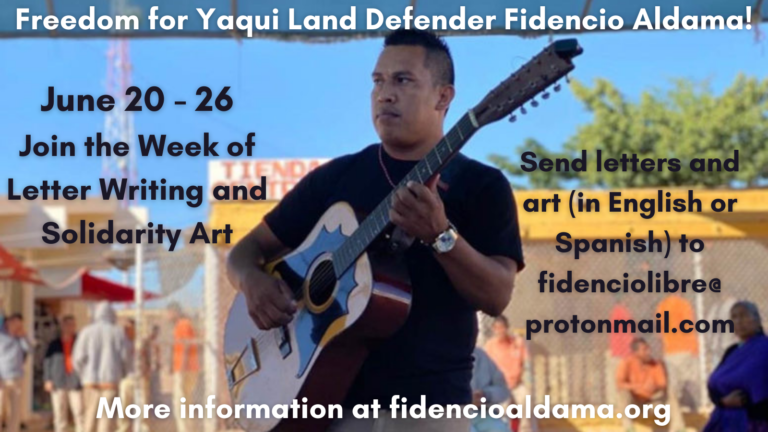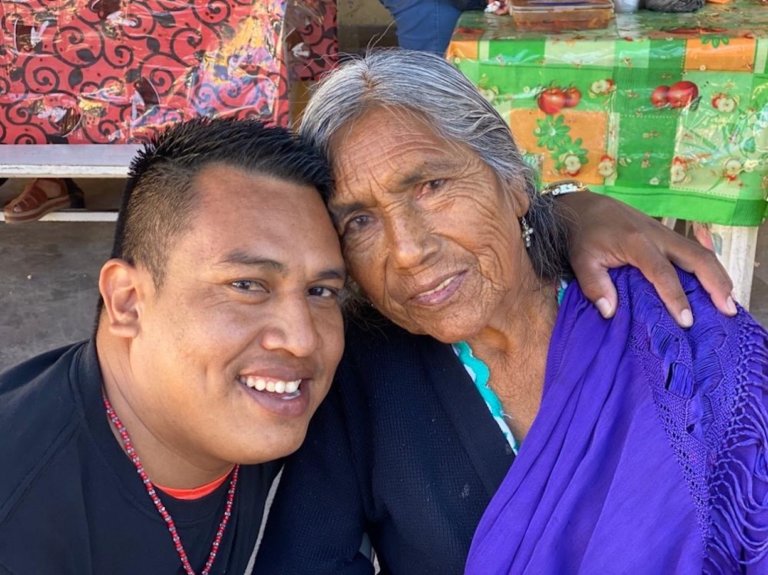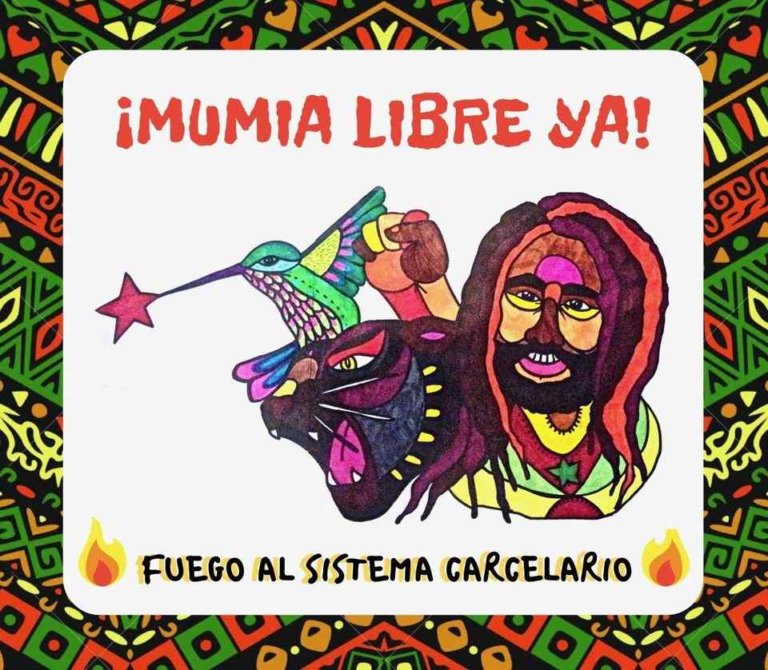Friday, August 21, Mexico City. Songs, photos and messages of a demonstration outside the federal Supreme Court building catch the attention of some passers-by.
One lady asks what the protest was about. “They just made sure justice was done in the Acteal case, didn’t they?”
“No, not really,” a protester explains. “When the Supreme Court let 20 of the shooters go last week, they put the lives of the pacifists in the Las Abejas organization in real danger. And the ones who planned the crime have never set foot in jail. They killed a baby, 14 children, 21 women and 9 men in cold blood. Do you think that’s justice?”
The meeting is held the same day that news comes out in Washington D.C. confirming the Mexican Army’s support for “anti-Zapatista armed groups” at the time of the Acteal massacre.
The voice of La Otra Cultura reaches people on the sidewalk:
“Take a look at these symbols. The little white boxes stand for the innocent children killed, and the black boxes stand for the adults. Forty-five compañeros Tzotziles were massacred while they were praying. And up there you see the faces of the ones who are responsible for their deaths.”
“We put them up there for all of you to see, all of you who are worn down by the crisis, who don’t earn enough to support your own kids. All of you, like us, who wonder where our next meal is coming from because we can’t pay the rent, because we can’t pay our debts. The only ones who don’t feel the crisis are the richest people in the country, the Carlos Slims, they’re the ones who take all the wealth we produce. They’re so happy to be part of high society, they think they’re beyond good and evil, but they’re not.”
“Look at that photo on the right. That’s Aguilar Camín, who’s defending the killers in the press. You’ve probably seen that jackass on TV acting like he’s a great intellectual, an analyst, a researcher, but he’s just a lackey who throws big words around to justify the Acteal massacre. He wants us to believe that the men who were convicted and jailed are innocent and that the Supreme Court was only doing justice when it turned 20 of them loose. Look at his face. Look at all their faces so you won’t forget them.”
At the end of 2006, Hector Aguilar Camín, Ricardo Raphael de la Madrid, the Judicial Studies Division of the Center for Economic Research and Education (CIDE) and the group known as Alternativa Ciudadana 21, “took over the legal and media defense of the perpetrators of the multi-homicide of 45 Tzotzil indigenous people of the Las Abejas civil society,” says Carlos Fazio in his article “The Subversion of History.” http://www.jornada.unam.mx/2007/12/31/index.php?section=opinion&article=016a1pol
The CIDE, a public institution under the jurisdiction of the Department of Public Education (SEP), allocated $551, 560 pesos for the defense of the individuals found guilty. “Of the total amount, the CIDE contributed $239, 679.86 pesos of its own funds, or 43.4 percent of the total; while the Hewlett Foundation contributed $266, 880.16 pesos, or 48.3 percent, and the Open Society Institute –founded by the entrepreneur George Soros–, another $45,000 pesos, 8.6 percent of the total.” http://www.jornada.unam.mx/2009/08/19/index.php?section=politica&article=011n1pol
A compañera from the Brigada Callejera speaks: “They’re using our taxes to defend the very ones who committed the massacre. They’re saying Acteal was a conflict between peoples or that it was a religious conflict, but it was a crime of State.”
Part of Carlos Montemayor’s article “Remembering Acteal”, is read out loud by a compañero of the Sector Obrero: “At 10:30 in the morning, they were kneeling in prayer in the chapel at Acteal, when shots were first heard. The contingent of aggressors wearing black uniforms and ski masks drove up, carrying high-caliber weapons. They were brought in from the communities of Los Chorros, Puebla, Chimix, Quextic, Pechiquil and Canolal in three-ton trucks. They opened fire at close range, shooting the displaced people in the back as they prayed; as people fled, they fell along the road and into the canyon. For six hours, the paramilitary contingent fired, killing dozens of victims.”
http://www.jornada.unam.mx/2007/12/17/index.php?section=opinion&article=010a1pol
The photos posted on the iron fence in front of the Supreme Court are of some of the main figures who promoted counterinsurgency and the formation of paramilitary groups in Chiapas, who ordered the crime or did nothing to stop it, who covered up the crime and who continue to do so, charges a comrade from La’k Hormiga. They are President Ernesto Zedillo, Governor José Ruiz Ferro and his successor Roberto “Croquetas” Albores Guillen; the Minister of the Interior Emilio Chuayffett and his successor Francisco Labastida Ochoa; the General of the Seventh Region Mario Renán Castillo; the federal Attorney General Jorge Madrazo Cuellar; the head of the National Human Rights Commission Mireille Roccatti; the supposed peace negotiators Marco Antonio Bernal and Gustavo Iruegas; Doctor Juan Ramón de la Fuente, and Hector Aguilar Camín.
That’s not all. There’s the head of the Chiapas Department of Public Safety Felipe Vázquez Espinoza. The Chiapas Secretary of State Homero Tovilla Cristiani. The Chiapas Under Secretary of State Uriel Jarquín Gálvez, and we could go on.
In a communiqué issued January 4, 1998, the Revolutionary Indigenous Clandestine Committee-General Comand of the EZLN says: “According to radio transmissions intercepted by the EZLN, the Chiapas Secretary of State is giving orders to the hired gunmen in the Heights of Chiapas to hide in a safe place. He tells them to bury their arms and wait until “the problem has been dealt with” before getting back “to work.” “You have to take it easy and let the protests die down,” says the voice of the mestizo who gave the instructions to someone at the PRI headquarters in Chenalhó. The intercepted transmission came from telephone number 8-48-33, said to be that of the San Cristobal office of the state government of Chiapas. Mr. Uriel Jarquín (Under Secretary of State of Chiapas) arranged everything in the Chiapas State Legislature for the so-called official Municipal Presidency to be filled by one of his staunchest supporters. That way they intended to make sure that what really happened at Acteal would be kept totally secret. Mr. Jarquín communicated with the PRI town government of Chenalhó to dictate the name of the person who would take the place of Jacinto Arias Pérez. “It will be Antonio Gómez. Tell them in the office that that’s what Uriel Jarquín says and that they are to obey.” The transmissions stress the importance of security for Manuel Hernández Pérez and Victorio Cruz Velázquez, as well as for the Judge and the Treasurer of the PRI government of Chenalhó, because “they know a lot about what happened and they mustn’t let themselves be caught.”
It’s clear to the demonstrators outside the Supreme Court building that the massacre at Acteal was part of a broader counterinsurgency strategy being applied in Chiapas. It’s important to mention that immediately after the massacre, the federal Army carried out house to house searches and looted in more than 30 Zapatista communities in Chiapas.
The singer from La Otra Cultura says: “They’re still at it. We denounce all those cutthroats ––the armed civilian groups, the Army, and Sabines, who’s now Governor of Chiapas. We’re here today for our indigenous brothers and sisters. They’ve taken away their right to live just to sell their lands to the transnationals. They’re a gang of thieves, and our only hope is to get organized against them.”
It’s also clear that the counterinsurgency strategy not only serves power interests in Mexico, but also the interests of Washington.
According to researcher Darin Wood, Seventh Region General Mario Renán Castillo was trained at the War College at Fort Bragg, North Carolina, “also the headquarters of the Seventh Special Forces Group, the Green Berets, responsible for actions in Latin America.” Wood mentions that the Special Forces Field Manual 31-20-3 for Foreign Internal Defense Tactics, Techniques and Procedures was published at Fort Bragg on September 20, 1994. The manual has a 19-page appendix on the formation of paramilitary groups or “civil self-defense patrols” in counterinsurgency actions. http://www.jornada.unam.mx/2002/11/02/017a1pol.php?origen=opinion.html
In the same article, Techniques,actions.”x on the formation of paramilitary groups or le in Mexico, but also the interests of ly hope is Wood says that General José Rubén Rivas Peña, on the other hand, received his training at the School of the Americas, established in Panama in 1946 and moved to Fort Benning, Geogia in 1984. (The school is now called the Western Hemisphere Institute for Security Cooperation.) Other Mexican military officers trained there include General Juan López Ortiz, charged with fighting the EZLN in Ocosingo in January of 1994; General Gastón Menchaca Arias, Commander of the 31 Military Zone at Rancho Nuevo, Chiapas; General Miguel Leyva García in charge of the 83rd Infantry Batallion of the same Military Zone, General Harold H. Rabling, specialist in Irregular Warfare Operations; Brigadier General Carmelo Terán Montero, specialist in Military Intelligence; General José Luis López Ruvalcaba, Commander of the Mixed Operations Base in the Seventh Military Region in Chiapas; and General Enrique Alonso Garrido, Commander of the 83rd Infantry Batallion at Rancho Nuevo in 1994.
The article by Montemayor that was read aloud at the demonstration refers to a military document revealed by Mexican journalist Carlos Marín in Proceso magazine on January 5, 1998, that had been prepared in 1994. The first part is a diagnostic study signed by General José Rubén Rivas Peña; the second, an analysis of “the contingents, locations, and political and military options of the EZLN;” and the third, “a war plan for the Army in Chiapas.” A section on “Training for paramilitary groups…describes Army activities in the training and support of self-defense forces and other paramilitary organizations, which can be the basic principle for the mobilization of development and military operations… En case civil self-defense forces don’t exist, it is necessary to create them.”
http://www.jornada.unam.mx/2007/12/17/index.php?section=opinion&article=010a1pol
The counterinsurgency strategy is confirmed in a report published by Kate Doyle of the National Security Archive in Washington on documents declassified by the Defense Intelligence Agency (DIA) of the United States. Doyle states that these documents contradict the White Book prepared by Attorney General Jorge Madrazo in 1998, in which the government affirms that the “The Attorney General’s office has documented the existence of groups of armed civilians in the municipality of Chenalhó, neither organized, created, trained, nor financed by the Mexican Army nor by any other government entity, but whose management and organization respond to an internal logic determined by the confrontation, between and within the communities, with the Zapatista bases of support.” (p. 32, emphasis added).
“In a telegram sent to DIA headquarters in Washington on May 4, 1999, the U.S. Defense Attaché Office in Mexico points to ‘direct support’ by the Army to armed groups in the highland areas of Chiapas, where the killings took place. The document describes a clandestine network of ‘human intelligence teams,’ created in mid-1994 with approval from then-President Carlos Salinas, working inside Indian communities to gather intelligence information on Zapatista ‘sympathizers.’ In order to promote anti-Zapatista armed groups, the teams provided ‘training and protection from arrests by law enforcement agencies and military units patrolling the region.’”
“The information was compiled by the agency’s representatives in Mexico, defense attaché officers whose primary task is to gather intelligence on the Mexican armed forces and send it to headquarters in Washington for analysis. The analysis is then used by the government to assist in crafting national security policy in Mexico. The agency is the eyes and ears of the U.S. Secretary of Defense abroad: think of it as the Pentagon’s CIA.”
“So the “internal logic” turns out to be the military’s, in the form of a carefully planned counterinsurgency strategy that combined civic action programs – frequently trumpeted by the Defense Secretariat in statements to the press – with secret intelligence operations designed to strengthen the paramilitaries and provoke conflict against EZLN supporters.” http://www.gwu.edu/~nsarchiv/NSAEBB/NSAEBB283/index2.htm
The Brigada Callejera takes the megaphone again: Who gave the order to kill our comrades? It came from very high up. The people most responsible are promoted and rewarded. What is the message to us? That the lives of indigenous people and the rest of us at the bottom of this society have no value at all for them. That they can kill us, rape us, do anything they want to us. But we keep our heads up and we aren’t fools. Just like they push globalization, we build our own kind of globalization in self-defense.
by carolina



